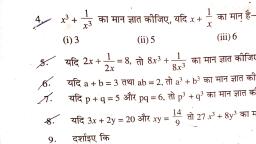Question 1 :
State True or False: A real number α is said to be a root of the quadratic equation a$x^2$ + bx + c = 0, if a$α^2$ + bα + c = 0.
Question 2 :
Find the roots of the following quadratic equation (by the factorisation method): $3\sqrt{2}x^2-5x-\sqrt{2}=0$
Question 3 :
A quadratic equation $ax^2 + bx + c =0$ has no real roots when :
Question 4 :
<img style='object-fit:contain' src='https://teachmint.storage.googleapis.com/question_assets/cbse_ncert/61b19bf5273b230584979a4d.jpg' />
Find the dimensions of the prayer hall given in the above figure.
Question 5 :
Check whether the following is quadratic equation : $(x+1)^2 = 2(x-3)$
Question 9 :
A train travels at a certain average speed for a distance of 63 km and then travels a distance of 72 km at an average speed of 6 km/h more than its original speed. If it takes 3 hours to complete the total journey, original average speed of the train is?
Question 10 :
Justify why the following quadratic equation has no two distinct real roots: $x\left(1-x\right)-2=0$
Question 11 :
Check whether the following is a quadratic equation: $x^2 – 2x = (–2) (3 – x)$
Question 13 :
Find the roots of the following quadratic equation (by the factorisation method): $3x^2+5\sqrt{5}x-10=0$
Question 14 :
State True or False: If the coefficient of $x^2$ and the constant term have the same sign and if the coefficient of $x$ term is zero, then the quadratic equation has no real roots.
Question 15 :
Represent the following situation in the form of a quadratic equation : A train travels a distance of 480 km at a uniform speed. If the speed had been 8 km/h lesss, then it would have taken 3 hours more to cover the same distance. We need to find the speed of the train.
Question 16 :
State true or false:
$b^2 – 4ac$ is called the discriminant of the quadratic equation $ax^2 + bx + c = 0$.
Question 17 :
State True or False whether the following quadratic equation has two distinct real roots: $\left(x+1\right)\left(x-2\right)+x=0$
Question 18 :
Does the following equation has the sum of its roots as 3? $3x^2-3x+3=0$
Question 20 :
Justify why the following quadratic equation has no two distinct real roots: $\left(x+4\right)^2-8x=0$
Question 21 :
State True or False whether the following quadratic equation has two distinct real roots: $3x^2-4x+1=0$
Question 22 :
Find the roots of the quadratic equation (by using the quadratic formula): $x^2-3\sqrt{5}x+10=0$
Question 23 :
Sum of the areas of two squares is $468 m^2$. If the difference of their perimeters is 24 m, find the sides of the two squares.
Question 25 :
Check whether the following is a quadratic equation: $(x – 2)(x + 1) = (x – 1)(x + 3)$























































